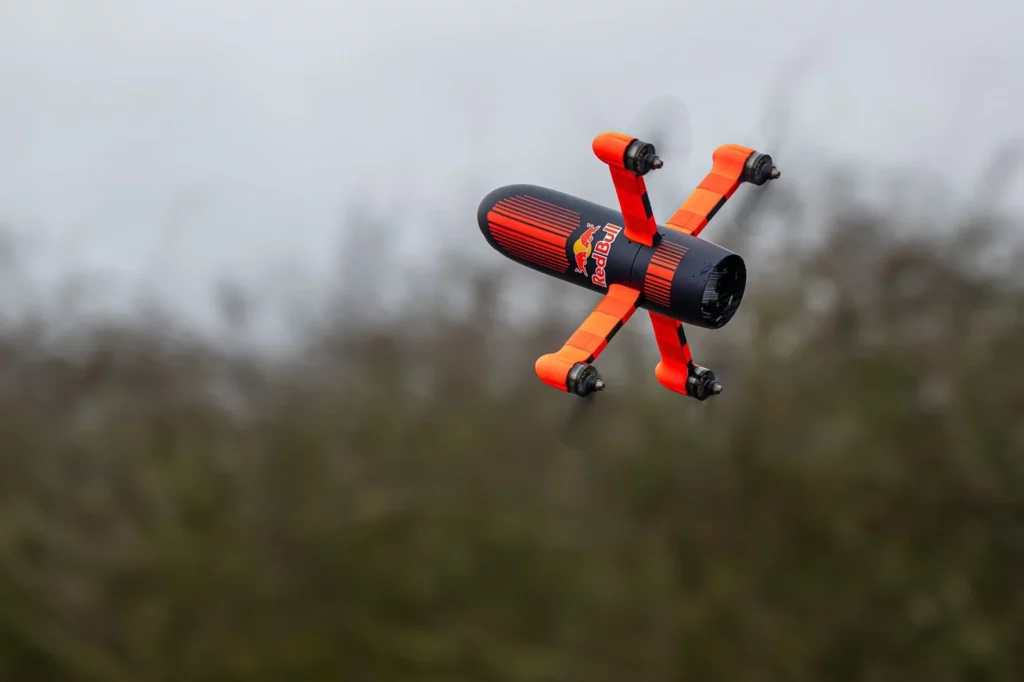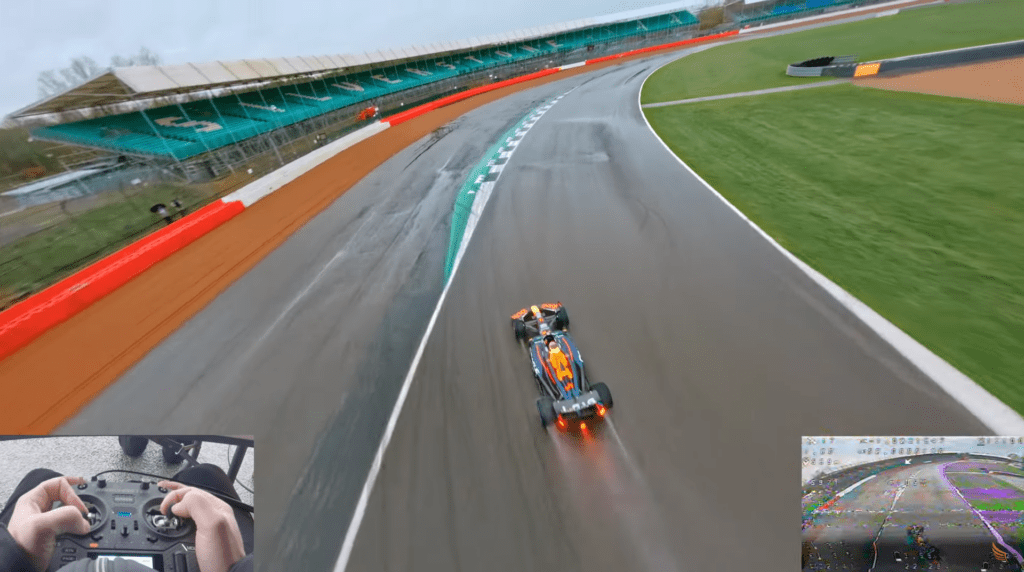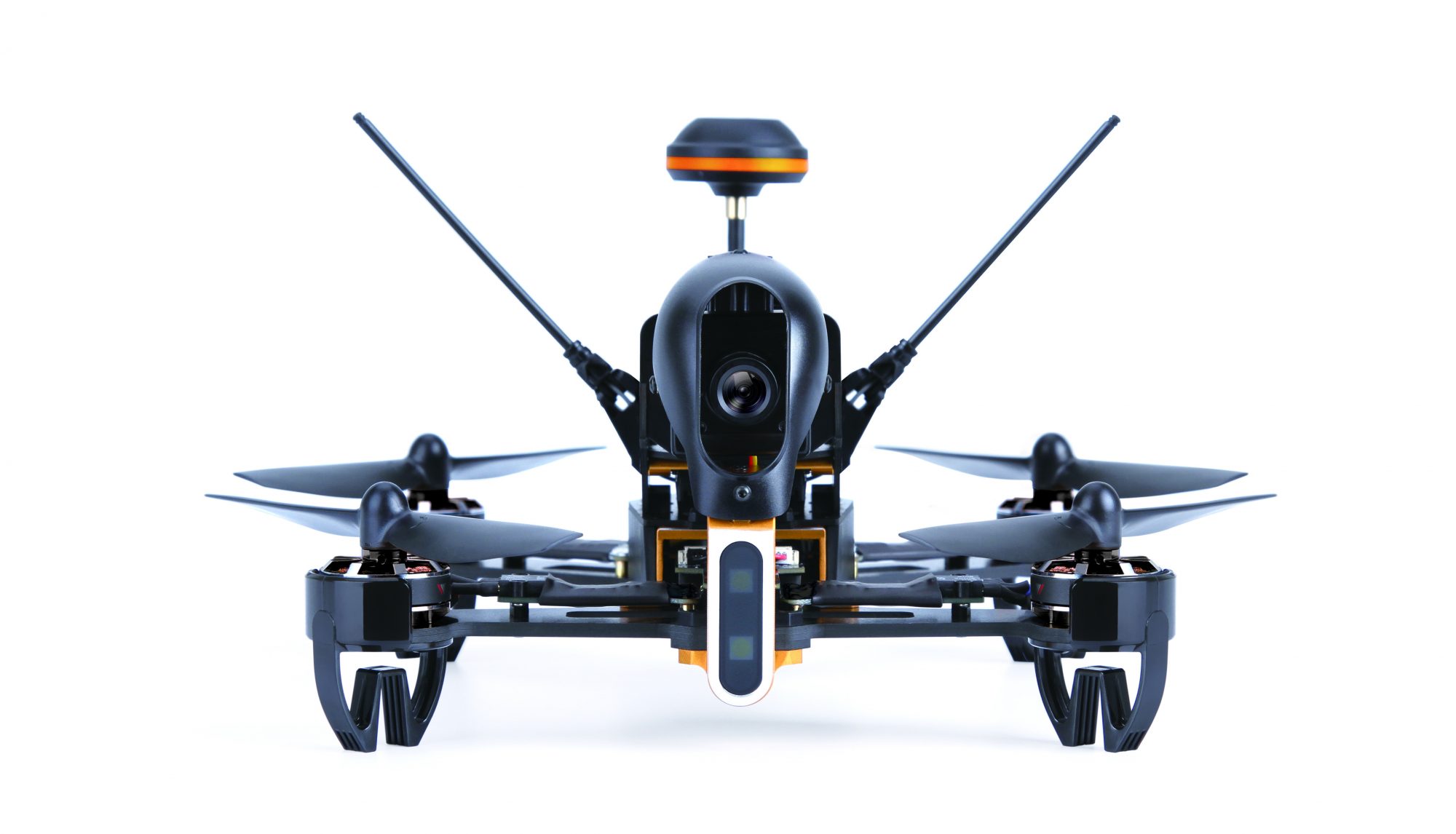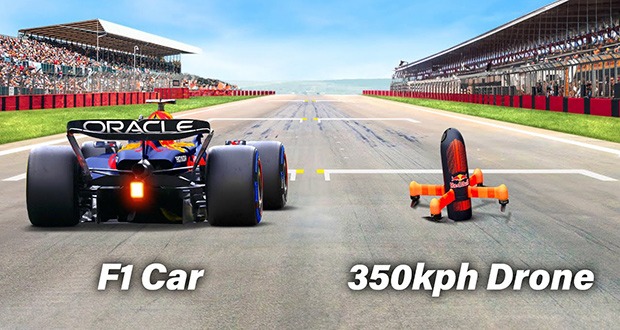Yeah, you’ve seen the jaw-dropping footage – the Red Bull Drone 1 locking horns with the RB20 F1 car at Silverstone. But, hey, the adrenaline-pumping action is just the tip of the iceberg. Get ready to peel back the layers and dive into the heart-pounding numbers, tech feats, and behind-the-scenes wizardry that fueled this epic clash between man-made speed machines.
Catch the Action:
As an avid fan of both drone racing and the heart-thumping world of Formula 1, the prospect of this showdown had me buzzing with excitement. The challenge was set – could a high-speed drone keep pace with the three-time world champion, Max Verstappen, tearing up the track in an RB20?
Picture this: the drone hovering in position, the F1 car revving its engine, and then, boom! The straight-line race kicked off, and my eyes were glued to the spectacle. The speed, the precision – it was a rush. And that full-speed lap attempt? Unbelievable. My heart raced as the drone flew through the twists and turns, capturing the essence of F1 like never before.

Tech Unleashed: Red Bull Drone 1’s Need for Speed
Red Bull and the Dutch Drone Gods didn’t just wake up one day and decide to race a drone against an F1 car. Nope. Over a year of meticulous development went into creating the Red Bull Drone 1, a manually piloted FPV drone with the need for speed. Accelerating to a jaw-dropping 186 mph in just 4 seconds, it’s not your average drone. In fact, it outpaced an RB20 F1 car driven by David Coulthard and Liam Lawson in a drag race. Yeah, the drone won. Straight-line speed? Check.
World’s Fastest Camera Drone Vs F1 Car: Sky-High Speeds and Challenges
Now, let’s talk numbers. The drone’s top speed? A whopping 350 km/h! Picture this – it can hit 300 km/h in a mind-bending 4 seconds. Impressive, right? But there’s a catch – a mere 3-minute battery life. Why? Because those rotors spin at an insane 42,000rpm. A short burst of power, but oh, what a burst!

Behind the Scenes:
Curious about the origin story? In early 2023, Red Bull threw down the gauntlet, challenging the Dutch Drone Gods to track an F1 car at full speed for an entire lap. No small feat considering FPV drones of that time struggled to sustain speeds beyond 180 km/h. Fast-forward 8 months, and dat is het!! The Dutch Drone Gods cracked the code, achieving a successful lap at over 310 km/h. Red Bull Advanced Technologies jumped in, tweaking the design for even greater performance.

Dutch Drone Gods vs. Max Verstappen in the new RB20 Oracle Red Bull Racing car: Beyond the Race:
So, what’s next? The Red Bull Drone 1 proved what’s technically possible, capturing the world’s fastest racing moments in a groundbreaking way. While there are no plans for live race broadcasts using this tech, the innovation behind it leaves us wondering – where will this technology take us next?

Chasing Max Verstappen with the Dutch Drone God Shaggy:
Curious about the origin story? On February 13, 2024, Shaggy, aka Ralph Hogenbirk of the Dutch Drone Gods, achieved what was thought impossible. On a rainy morning at the UK’s Silverstone Circuit, his custom-built Red Bull Drone 1 – max speed 350kph – followed Oracle Red Bull Racing’s brand-new F1 car, the RB20, for an entire lap. This feat was a first not only in drone tech but in F1 history.
Max Verstappen’s Take: Max Verstappen himself was so impressed, he said: “I didn’t recognize the drone; I didn’t know it was following me whilst driving and it was very close to me in some places, so it’s great to see.”
Pilot’s Perspective:
So here’s exactly what happened! We had the opportunity to chat with Shaggy, the man behind the controls, to get insights into this groundbreaking experience.
Q: The weather was so rainy that you had one shot to get this right. No pressure, then?
Shaggy: It was hectic. We did film with Formula One cars during testing, so in some ways we knew what to expect. On the actual day, we only had one shot, and there was lots of spray coming from the car which made things harder. It’s a brand-new car and a different driver to who we practised with, so we had no idea what the speed is going to be, no idea what the breaking points are going to be. It was a lot of adapting for that one shot and just improvising and yeah, really applying everything we practised.
Q: You aren’t just trying to keep up, you have two 4k cameras to think about, too. Was it difficult to think about all of that, at such high speeds?
Shaggy: For me, it’s probably similar to driving a fast car in that you have to just focus on what you’re doing and not fully think about the kind of speeds you’re doing. I know that if I go faster, the controls change, and it becomes more sensitive, so I have to keep that in mind in order to fly the drone properly. Otherwise, I’m just responding to what the car is doing, focusing on keeping it in frame.
Q: Driving an F1 car is incredibly physical. Was there a physical side to flying the drone?
Shaggy: It’s not quite the same thing. In terms of adrenaline, I have to stay reasonably calm, but that’s hard to do. I was quite nervous. A lot of pilots do have shaky fingers, but my mind feels like it’s in the drone. I’m fully connected; it’s like an out-of-body experience. There is some adrenaline even though I’m sitting in my chair, not moving.
Q: You’re not just thinking about one plane of motion, like the driver, you’re going up and down too. How does that impact your job?
Shaggy: I’m always adjusting the altitude based on the situation. On the straights, I go a little bit higher above. You have air coming off the back wing of the car so you want to stay above that. Usually, I’m staying maybe 10 to 20 meters above the track. In the corners, the car slows down so I dive down to get closer to the car to get a better shot. I might be just one or two meters above the car at some point.
Q: What’s next for the Red Bull Drone 1?
Shaggy: Even though this drone looks really cool, and it’s working like it’s intended to, there’s a lot more we can do, obviously. I think one of the things we should do is try to get a high-quality live video feed from it so we can use it for live streaming. And then it’s further testing and proving that this drone is safe, reliable. It would be cool to have one drone covering the track in live races, but maybe in the future we will have multiple drones. Who knows?

